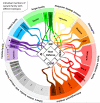All For One and One For All on the Tick-Host Battlefield
- PMID: 26830726
- PMCID: PMC4851932
- DOI: 10.1016/j.pt.2016.01.004
All For One and One For All on the Tick-Host Battlefield
Abstract
The saliva of ixodid ticks contains a mixture of bioactive molecules that target a wide spectrum of host defense mechanisms to allow ticks to feed on the vertebrate host for several days. Tick salivary proteins cluster in multigenic protein families, and individual family members display redundancy and pluripotency in their action to ameliorate or evade host immune responses. It is now clear that members of different protein families can target the same cellular or molecular pathway of the host physiological response to tick feeding. We present and discuss our hypothesis that redundancy and pluripotency evolved in tick salivary immunomodulators to evade immune recognition by the host while retaining the immunomodulatory potential of their saliva.
Keywords: immunomodulation; multigenic protein families; pluripotency; redundancy; silent antigens; tick salivary proteins.
Copyright © 2016 Elsevier Ltd. All rights reserved.
Figures



Similar articles
-
Displaced tick-parasite interactions at the host interface.Parasitology. 1998;116 Suppl:S65-72. doi: 10.1017/s003118200008495x. Parasitology. 1998. PMID: 9695111 Review.
-
Tick immunobiology.Parasitology. 2004;129 Suppl:S161-76. doi: 10.1017/s0031182004004834. Parasitology. 2004. PMID: 15940820 Review.
-
Tick saliva in anti-tick immunity and pathogen transmission.Folia Microbiol (Praha). 2004;49(3):327-36. doi: 10.1007/BF02931051. Folia Microbiol (Praha). 2004. PMID: 15259776 Review.
-
Ticks' tricks: immunomodulatory effects of ixodid tick saliva at the cutaneous tick-host interface.Front Immunol. 2025 Mar 27;16:1520665. doi: 10.3389/fimmu.2025.1520665. eCollection 2025. Front Immunol. 2025. PMID: 40213541 Free PMC article. Review.
-
Immune recognition of salivary proteins from the cattle tick Rhipicephalus microplus differs according to the genotype of the bovine host.Parasit Vectors. 2017 Mar 14;10(1):144. doi: 10.1186/s13071-017-2077-9. Parasit Vectors. 2017. PMID: 28288696 Free PMC article.
Cited by
-
Iripin-3, a New Salivary Protein Isolated From Ixodes ricinus Ticks, Displays Immunomodulatory and Anti-Hemostatic Properties In Vitro.Front Immunol. 2021 Mar 1;12:626200. doi: 10.3389/fimmu.2021.626200. eCollection 2021. Front Immunol. 2021. PMID: 33732248 Free PMC article.
-
Tick-Host-Pathogen Interactions: Conflict and Cooperation.PLoS Pathog. 2016 Apr 21;12(4):e1005488. doi: 10.1371/journal.ppat.1005488. eCollection 2016 Apr. PLoS Pathog. 2016. PMID: 27099928 Free PMC article. Review. No abstract available.
-
Deciphering Biological Processes at the Tick-Host Interface Opens New Strategies for Treatment of Human Diseases.Front Physiol. 2019 Jul 3;10:830. doi: 10.3389/fphys.2019.00830. eCollection 2019. Front Physiol. 2019. PMID: 31333488 Free PMC article. Review.
-
Prevention of tick-borne diseases: challenge to recent medicine.Biologia (Bratisl). 2022;77(6):1533-1554. doi: 10.1007/s11756-021-00966-9. Epub 2022 Mar 9. Biologia (Bratisl). 2022. PMID: 35283489 Free PMC article. Review.
-
The Use of Tick Salivary Proteins as Novel Therapeutics.Front Physiol. 2019 Jun 26;10:812. doi: 10.3389/fphys.2019.00812. eCollection 2019. Front Physiol. 2019. PMID: 31297067 Free PMC article. Review.
References
-
- Sonenshine DE, Roe RM. Biology of ticks. Oxford University Press; 2014.
Publication types
MeSH terms
Substances
Grants and funding
LinkOut - more resources
Full Text Sources
Other Literature Sources

